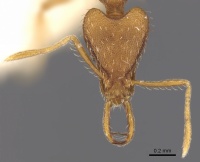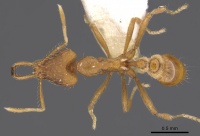Strumigenys hispida
| Strumigenys hispida | |
|---|---|

| |
| Scientific classification | |
| Kingdom: | Animalia |
| Phylum: | Arthropoda |
| Class: | Insecta |
| Order: | Hymenoptera |
| Family: | Formicidae |
| Subfamily: | Myrmicinae |
| Tribe: | Attini |
| Genus: | Strumigenys |
| Species: | S. hispida |
| Binomial name | |
| Strumigenys hispida Lin & Wu, W.-J., 1996 | |
Nothing is known about the biology of Strumigenys hispida.
Identification
A member of the smythiesii complex in the Strumigenys godeffroyi-group.
Keys including this Species
Distribution
Tang & Guenard (2023) - The record in Hainan Province (Fig. 22A–C) fits in the current distribution of the species, while the record in northern Vietnam (Fig. 22D–F) extends its native range south-westward. Its presence in Hong Kong is also likely. The current disjunction in geographical range between Henan and the other southern provinces can be expected to be filled by further sampling efforts.
Distribution based on Regional Taxon Lists
Oriental Region: Taiwan (type locality), Vietnam.
Palaearctic Region: China.
Distribution based on AntMaps
Distribution based on AntWeb specimens
Check data from AntWeb
Countries Occupied
| Number of countries occupied by this species based on AntWiki Regional Taxon Lists. In general, fewer countries occupied indicates a narrower range, while more countries indicates a more widespread species. |

|
Estimated Abundance
| Relative abundance based on number of AntMaps records per species (this species within the purple bar). Fewer records (to the left) indicates a less abundant/encountered species while more records (to the right) indicates more abundant/encountered species. |

|
Biology
|
Castes
Nomenclature
The following information is derived from Barry Bolton's Online Catalogue of the Ants of the World.
- hispida. Strumigenys hispida Lin & Wu, 1996: 145, figs. 15-19 (w.q.) TAIWAN. See also: Bolton, 2000: 808.
Unless otherwise noted the text for the remainder of this section is reported from the publication that includes the original description.
Description
Worker
Bolton (2000) - TL 2.8-2.9, HL 0.70-0.72, HW 0.51-0.52, CI 72-73, ML 0.34, MI 47-49, SL 0.44, SI 85-86, PW 0.29-0.30, AL 0.74-0.76 (2 measured). Characters of smythiesii-complex. Apicoscrobal hair short; upper scrobe margin anterior to this without freely projecting hairs but posteriorly there are 3-4 similar hairs on the dorsolateral margin of the occipital lobe. In profile cephalic dorsum with a transverse row of short erect hairs at the occipital margin; anterior to this with inclined ground-pilosity but without a pair of erect hairs near highest point of vertex. Pronotal humeral hair stiff and simple, straight or slightly curved. Pronotal dorsum with 1 pair and mesonotum with 3 pairs of short erect simple hairs. Entire dorsal alitrunk finely and densely punctate to reticulate-punctate. Lamella on propodeal declivity about the same width throughout or only fractionally broader basally, its posterior (free) margin approximately straight in profile or at most only feebly convex. With petiole in profile the lateral spongiform lobe not reaching the anterior face of the node but extending distinctly anterior to the midlength of the node. Dorsum of petiole node finely and densely punctate to reticulate-punctate; disc of postpetiole smooth. Erect hairs on first gastral tergite restricted to two transverse rows, one near base, the other near apex. Basigastral costulae distinct on first gastral tergite. See notes under Strumigenys solifontis.
Type Material
Bolton (2000) - Holotype worker, paratype workers and queen, TAIWAN: Nantou Hsien, Chitou, 30.xi.1992 (C. -C. Lin); paratype workers and queens, TAIWAN: Chiai Hsien, Fenchifu, 3.ix.1992 (C. -C. Lin); Han Hsien, Fushan, 9.x.1992 (C. -c. Lin); Taipei Hsien, Wulai, 2.x.1992 (C. -C. Lin) (National Taiwan University, Taiwan Agricultural Research Institute, The Natural History Museum) [examined].
Etymology
Named from the Latin "hispidus", which means hair.
References
- Bolton, B. 2000. The ant tribe Dacetini. Memoirs of the American Entomological Institute. 65:1-1028.
- Lin, C.-C.; Wu, W.-J. 1996. Revision of the ant genus Strumigenys Fr. Smith (Hymenoptera: Formicidae) of Taiwan. Chin. J. Entomol. 16: 137-152 (page 145, figs. 15-19 worker, queen described)
- Tang, K. L., Guénard, B. 2023. Further additions to the knowledge of Strumigenys (Formicidae: Myrmicinae) within South East Asia, with the descriptions of 20 new species. European Journal of Taxonomy 907, 1–144 (doi:10.5852/ejt.2023.907.2327).
- Wang, C., Chung, F.-Y., Lin, C.-C., Gibson, J. C., McGuire, S., Suarez, A. V., Billen, J. 2023. The spongiform tissue in Strumigenys ants contains exocrine glands. Arthropod Structure & Development 73, 101246 (doi:10.1016/j.asd.2023.101246).
- Wang, C., Lin, C.-C., Keller, R.A., Billen, J. 2021. The ‘hairwheels’ in Strumigenys ants are not glandular. Asian Myrmecology 13: e013004 (doi:10.20362/am.013004).
- Wang, C., Sung, P.-J., Lin, C.-C., Ito, F., Billen, J. 2023. Parthenogenetic reproduction in Strumigenys ants: An update. Insects 14, 195 (doi:10.3390/insects14020195).
References based on Global Ant Biodiversity Informatics
- Bolton, B. 2000. The Ant Tribe Dacetini. Memoirs of the American Entomological Institute 65
- Guénard B., and R. R. Dunn. 2012. A checklist of the ants of China. Zootaxa 3558: 1-77.
- Lin C.C., and W.J. Wu. 1996. Revision of the ant genus Strumigenys Fr. Smith (Hymenoptera: Formicidae) of Taiwan. Chinese Journal of Entomology 16:137-152.
- Terayama M. 2009. A synopsis of the family Formicidae of Taiwan (Insecta: Hymenoptera). Research Bulletin of Kanto Gakuen University. Liberal Arts 17:81-266.
- Terayama, M. 2009. A synopsis of the family Formicidae of Taiwan (Insecta; Hymenoptera). The Research Bulletin of Kanto Gakuen University 17: 81-266.
- Zhou S.-Y. 2001. Ants of Guangxi. Guangxi Normal University Press, Guilin, China, Guilin, China. 255 pp.


